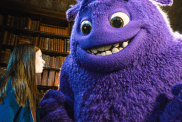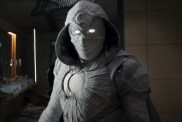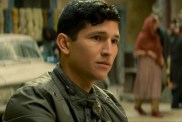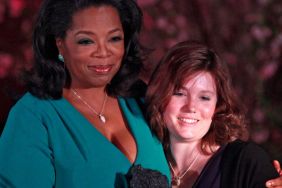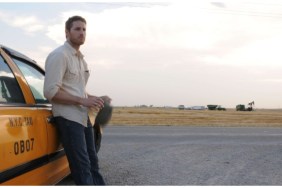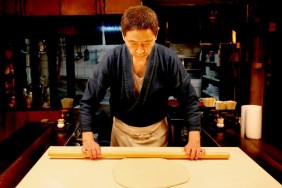Cast:
Ryan Gosling as Driver
Carey Mulligan as Irene
Bryan Cranston as Shannon
Albert Brooks as Bernie Rose
Oscar Isaac as Standard Gabriel
Ron Perlman as Nino
Christina Hendricks as Blanche
Christian Cage as Christian
James Biberi as Chris Cook
Kaden Leos as Benicio
Directed by Nicolas Winding Refn
Story:
An unnamed driver (Ryan Gosling) works at the garage of his friend Shannon (Bryan Cranston) and a stunt driver by day and a getaway driver for criminals at night. Shanon’s latest scheme involves getting into racing with a local criminal named Bernie Rose (Albert Brooks) but the driver has befriended his neighbor Irene (Carey Mulligan) and agrees to help her husband (Oscar Isaac) get out of trouble with thugs hassling him for money, pulling them both deep into something
Analysis:
After a summer of high-speed action movies, “Drive” puts its foot firmly on the brakes as it acts as absolute and positive proof Danish filmmaker Nicolas Winding Refn is indeed a cinematic genius, as he has created a film that will have people talking about for a very long time.
We meet Gosling’s nameless driver as he’s on a job as the getaway driver for a robbery, seeing how he uses his skills to evade police in order to get his clients safely away from whatever crime they’ve committed. This opening scene is quite fantastic as Refn finds a way of capturing modern-day Los Angeles in a way that hasn’t been seen on film for many decades. When the credits begin with a synth-heavy song that sounds like something straight from the cheesiest ’80s action movie, you know that you’re in for something different.
Working at the auto shop of a former convict who never quite got out of his funk, our driver meets his neighbor Irene, played by Carey Mulligan, a pretty and equally soft-spoken woman raising her son while his father Standard Gabriel (Oscar Isaac) serves prison time. All three of them immediately bond, but when Standard is released, the driver finds himself in a strange position but even moreso when Standard falls foul of thugs strong-arming him for protection money. Gosling’s character realizes that in order to protect Irene, he must help her husband.
At first, “Drive” is fairly quiet and subdued moving at a surprisingly slow pace for an action movie, but it ultimately unfolds into a smashing crime story, a modern noir that immediately reminds one of Cronenberg’s “A History of Violence” in the way things play out. Despite being Refn’s first true studio release, it’s more like his “Pusher trilogy” than anything else he’s done since, only this time with far better production values, and he certainly hasn’t set aside his eccentric sense of humor or less-than-mainstream sensibilities.
That can be seen right off the bat in Gosling’s performance. His character is immensely likeable but Gosling’s delivery takes some getting used to. At times, his character seems almost autistic, and at others, he’s absolutely psychotic, and it’s the subtlety in Gosling’s ability to express a lot with very little expression that lets him get away with barely saying a dozen words in the entire film. This decision makes some of the dialogue scenes a bit awkward, though. While he may seem quiet and polite, we soon learn what happens when he’s pushed, unleashing explosive levels of violence. These are the scenes that will probably offer the biggest takeaway as Refn once again shows his unflinching resolve to show violence in its most raw and primal form, which makes the Cronenberg comparison even more apropos. As much as the first half offers some quieter moments, it soon leads to a second half that has chase sequences and gun fights, all filmed and edited in a style that’s truly unique to Refn’s style.
Gosling doesn’t have to carry this alone as the rest of the cast is quite fantastic, Cranston squeezing every ounce of sleaze out of the handler who gets in over his head when he makes a deal with a gangster. Albert Brooks hasn’t really done much drama in recent years, so to see him depicting such a delicious baddie as Bernard Rose, watching him grow progressively more despicable and violent as the film goes along, really raises the bar on everything. His henchman (for lack of a better term) Nino presents another outrageously funny character for Ron Perlman to add to his repertoire, playing him up as a goombah wannabe of sorts. In fact, when you’ve assembled such an eclectic cast of characters and Carey Mulligan’s performance ends up being the most disappointing–we’ve seen her play far more interesting characters than Irene–you know you’ve created something truly special.
Visually, the film is stunning, the use of lighting being unlike anything we’ve seen in recent memory, then you add to that an eerie synth-driven soundtrack by Cliff Martinez combined with impeccable sound design–the ambient throbbing that permeates the entire movie makes the presence of natural atmospheric sounds even eerier once it stops–and Refn’s sense of humor extends to the ’80s inspired pop songs–College’s “A Real Hero” is so corny and cheesy it actually kind of works. All of these decisions just makes the movie as innovative aurally as it is visually.
The Bottom Line:
The slow pace and eclectic tone might take some adjusting to, but there’s no denying that “Drive” is absolutely brilliant filmmaking, mixing the stylish cinematography and production design of Kubrick, the quirky laidback tone of vintage David Lynch and the violence of Cronenberg. Refn is clearly one of the most underrated filmmakers working today and “Drive” is the type of movie you’ll probably want to see more than once to really appreciate the finer details of what he has achieved with it.
Drive premieres at the Toronto International Film Festival on Saturday, September 10, then opens nationwide on September 16.

